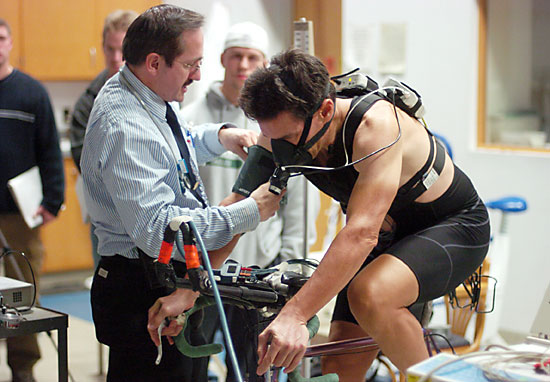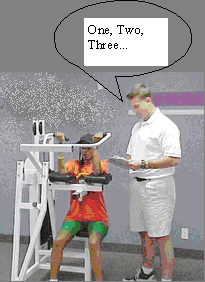Certified Versus Qualified: The Jillian Michaels Debate Rolls On
There was a recent post in the LA Times written by a trainer in Calgary (Yay Canada!!!) who pretty much tore Jillian Michaels a new one when he reviewed her Kettlebell DVD that was recently launched. This has since been picked up by a number of other trainers and become sort of viral. As any reader to this blog may know, I’m not a fan of Ms. Michaels. In fact, I would go so far as to say I would probably speed up if I saw her crossing the street in front of me, and would love to have a beer or two with her and teach her what an actual squat should look like.
However one thing that sticks in my mind is some of the comments that were posted directly on the LA Time’s article section defending her and her conviction. One even went out of its way to say that Jillian was “recently re-certified,” as if it were a big achievement to have the check clear. I do agree that there are two sides to every story, and while every trainer in the world is ripping her apart like a spider monkey with an apple, I’ll give her the due respect that she is entitled to. She does possess a valid certification, and she does get results for a lot of people. (However to be honest, a nutless monkey could yell at someone who is morbidly obese and make them sprint on a treadmill and have them lose weight, as pretty much any activity coupled with a low-calorie diet will work). She does a good job of motivating people, which is evident by the thousands of rabid followers who have drunk the Kool Aid she’s selling.
Now the question of certification has to come up. There are literally thousands of ways to become a “certified” personal trainer. Check out Google and type in “personal trainer certification,” and you’ll get about 5 million hits. You can even become a Certified Personal Trainer today by enrolling in the Expert Rating Certified Professional Personal Training program, paying the $69.99 fee, and taking the on-line exam. See you at the Squat Rack!!!
While I almost dry-heaved up my morning yogurt and granola when I saw this, I thought to myself “What does this say about the certified trainers out there!?!??” There aren’t many other qualified professions out there that have such lax standards in attaining credence. You wouldn’t find an accountant who would take this kind of route, or a doctor or mechanic, or even a journalist. So can we find it at all strange that a trainer, like Ms. Michaels can become so successful with such a large following, call herself certified, and still have so many people find so many egregious faults with every single thing she does? The public doesn’t have a clue what certified actually means, and there’s a big gap between “certified” and “qualified” fitness professionals.
So today, I thought I would tear apart the most common fitness certifications, what they involve in the application process, who can apply to them, and what the people who have them can actually do for you. This will get messy, so get out the body bags.
Cert #1: Can Fit Pro
I’m a PRO Trainer with Can Fit Pro, which means I teach the courses and conduct the exams to get new trainers certified with Can Fit Pro. While I’ll be the first to admit that it’s literally a foot in the door type of certification that gives trainers a basic level of knowledge of anatomy, physiology, exercise adaptation and program design, it quite literally scrapes the surface of knowledge. The prerequisites for taking the course are two legs and a heart beat, and they’re pretty forgiving on the two legs part. The exam process is actually pretty thorough, though, involving both a written and practical exam to test applicants abilities to take a client through a safe and effective workout.
The cert costs about $400 and includes study material, exams and course registration. The course is roughly 26 hours long.
Cert #2: NESTA
Jillian Michaels cert du jour, NESTA is an at-home certification that combines video learning, textbooks, and on-line quizzes before testing examinees in a proctored exam. The pre-requisites are the same as for Can Fit Pro, but they go into more detail on business development and have some additional resources like the on-line video series that Can Fit Pro doesn’t have.
The cost is $449 US, and give you 90 days to prepare for your exam. There’s no practical exam.
Cert #3: ACE
ACE is a very popular certification in the same vein as the previous two, and is popular among trainers who work in major health clubs in the states. The same prerequisites here as for the other 2, 18 and a CPR certificate.
The premier package costs $579, and the exam can be either written or on-line. There’s no practical exam.
SO I know you’re probably thinking “This is ridiculous!! How can it be so easy to be a trainer??” The simple answer is that exercise should be inclusive, meaning that everyone should have access to a trainer. A basic certification lets trainers work with people who have no known medical conditions, relatively healthy, and looking to improve their health and fitness. The downside is that the majority of people out there have been injured once or twice, and a lot of people have assorted health issues. Getting a trainer who doesn’t know what they’re doing to work with these kinds of clients is both dangerous and incredibly dumb. More advanced certifications are available for trainers who want to work with the biggest slice of the population, and to be able to do more than the basics of program design and exercise intervention.
Cert #4 Certified Exercise Physiologist
This is the highest level of certification a trainer can get in Canada, and is akin to a Medical Exercise Specialist offered through the American College of Sports Medicine in the US. The pre-requisites are a University degree in kinesiology or physical education and 200 hours of on the job training. The course is 100 hours of combined in-class lecture from PhD’s and Masters degree holders who specialize in their respective disciplines and laboratory work in exercise physiology. When completed, the trainer has the ability to work with clients who have had heart conditions, transplants, injuries, medical complications, and also to provide a level of medical clearance to a certain extent to those clients who need screening. It combines a written exam with a two-day practical exam.
The course fee is $1134, and the exam fee is $650, plus the study material is a combination of 6 different high-level text books, meaning the cost is pretty steep. This makes a big difference in who applies for the certification, as most trainers who aren’t serious about their education will decide to not persue it due to the cost.
Cert #5: Certified Personal Trainer
This is a certification that is becoming more popular each year, and is offered to those who have completed 2 years of a post-secondary program, much like the NAIT Personal Fitness Trainer or Mount Royal Personal Fitness Trainer diplomas. It involves a 44 hour workshop that goes over the basis of standardized fitness assessment, program design, counselling, and exercise physiology, and finishes with a written and practical exam
The cost is roughly $600 including exams and course fee.
Cert #6: Certified Strength and Conditioning Specialist
This is a go-to certification for a lot of sport performance trainers, and those who hold advanced degrees and educational components. It teaches about the adaptations involved in sport performance settings, program design considerations, periodization, and training methodologies used to get optimal performance. This also has a lot of carry-over in training non-athletic clients.
The pre-requisites are a university degree. The cost is $295 plus study material, and has a pretty tough pass-fail ratio.
Now for the bad news: The certification a trainer has will mean nothing if they don’t know enough about when and how to use that knowledge. I’ve known dozens of highly educated trainers who couldn’t do a thing with a live body in front of them, as well as a lot of basic certified trainers who could run laps around the first group in their ability to relate to their clients and motivate them to see success. Knowledge is power, but a little knowledge in the wrong hands can be dangerous. If trainers want to work outside of their scope of practice, that’s a liability waiting to happen. Anyone can be a trainer, but not everyone has the devotion, determination and desire to become one of the best of the best by increasing their knowledge base consistently.
If you’re looking for a qualified trainer, here are some steps to take to find one who will work for you.
Check their certifications. Make sure they are legit and up to date.
Look into their reputation. Don’t just look at what their best clients are saying about them, because it will be somewhat tainted. Talk to other trainers or other people in the local fitness community who may know that person and see what they think.
Talk to them, and see if they know what it takes to work with you. If you have medical conditions or old injuries, ask them about their knowledge of those conditions and see if they know their stuff. If they don’t, walk. Not knowing whether a specific spine is flexion intolerant or extension intolerant could be the difference between healing and re-injury.
How long have they been a trainer, and what do they do for expanding their knowledge? I know a few people who have been trainers for 20 years, and have been doing the wrong things for 20 years. Experience doesn’t equate to expertise. Find out the things they are doing to learn and grow.


6 Responses to Certified Versus Qualified: The Jillian Michaels Debate Rolls On